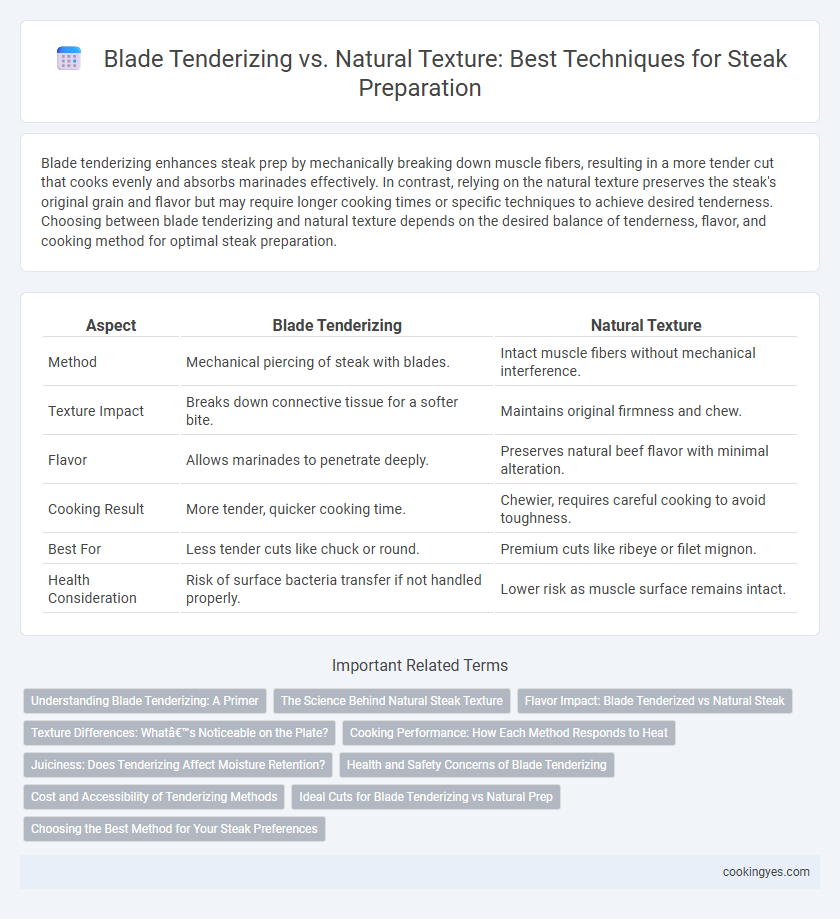Blade tenderizing enhances steak prep by mechanically breaking down muscle fibers, resulting in a more tender cut that cooks evenly and absorbs marinades effectively. In contrast, relying on the natural texture preserves the steak's original grain and flavor but may require longer cooking times or specific techniques to achieve desired tenderness. Choosing between blade tenderizing and natural texture depends on the desired balance of tenderness, flavor, and cooking method for optimal steak preparation.
Table of Comparison
| Aspect | Blade Tenderizing | Natural Texture |
|---|---|---|
| Method | Mechanical piercing of steak with blades. | Intact muscle fibers without mechanical interference. |
| Texture Impact | Breaks down connective tissue for a softer bite. | Maintains original firmness and chew. |
| Flavor | Allows marinades to penetrate deeply. | Preserves natural beef flavor with minimal alteration. |
| Cooking Result | More tender, quicker cooking time. | Chewier, requires careful cooking to avoid toughness. |
| Best For | Less tender cuts like chuck or round. | Premium cuts like ribeye or filet mignon. |
| Health Consideration | Risk of surface bacteria transfer if not handled properly. | Lower risk as muscle surface remains intact. |
Understanding Blade Tenderizing: A Primer
Blade tenderizing mechanically breaks down muscle fibers by using small blades to pierce the steak, resulting in a more tender texture and faster cooking times. This process is particularly effective for tougher cuts like chuck or round, enhancing juiciness and flavor absorption while reducing chewiness. Unlike natural texture preservation, blade tenderizing alters the steak's structure, enabling consistent tenderness but requiring careful handling to avoid over-tenderization.
The Science Behind Natural Steak Texture
Natural steak texture results from the muscle fibers' structure and the connective tissue composition, primarily collagen and elastin, which influence tenderness and juiciness. Enzymes like calpains and cathepsins play a crucial role in breaking down muscle proteins during aging, enhancing meat's natural tenderness without mechanical intervention. Blade tenderizing physically breaks muscle fibers and connective tissue, which can alter the steak's surface texture and cause moisture loss, whereas natural tenderization preserves the steak's intrinsic flavor and fiber integrity.
Flavor Impact: Blade Tenderized vs Natural Steak
Blade tenderizing breaks down muscle fibers and connective tissue, creating a more uniform texture that allows marinades and seasonings to penetrate deeper, intensifying the steak's flavor profile. Natural texture steaks maintain their original muscle structure, offering a more robust and complex taste due to less surface area exposure but often require higher quality cuts for optimal flavor. The flavor impact of blade tenderized steaks is generally more consistent and accessible, while natural texture steaks deliver a richer, more nuanced flavor favored by steak purists.
Texture Differences: What’s Noticeable on the Plate?
Blade tenderizing creates uniform tenderness by breaking down connective tissues, resulting in a consistently soft texture throughout the steak. Natural texture steak preserves the muscle fibers and grain, providing a chewier bite with more pronounced meat flavor and varied mouthfeel. On the plate, blade-tenderized steaks appear more refined and easy to cut, while naturally textured steaks offer a more rustic and satisfying chew experience.
Cooking Performance: How Each Method Responds to Heat
Blade tenderizing steaks creates small cuts in the meat, allowing heat to penetrate more evenly and reducing cooking time while maintaining juiciness. Natural texture steaks retain muscle fibers intact, leading to a firmer bite and slower, more gradual heat absorption that enhances flavor development through Maillard reactions. Blade-tenderized cuts can sometimes lose surface crispness but excel in tenderness, whereas naturally textured steaks often develop a more complex crust with a chewier interior during cooking.
Juiciness: Does Tenderizing Affect Moisture Retention?
Blade tenderizing breaks down muscle fibers in steak, increasing tenderness but can cause moisture loss through puncture wounds, slightly reducing juiciness. In contrast, relying on the steak's natural texture preserves the muscle structure, retaining more internal juices during cooking. Moisture retention is higher in naturally textured steaks, while blade tenderizing prioritizes tenderness at a minor cost to juiciness.
Health and Safety Concerns of Blade Tenderizing
Blade tenderizing mechanically pierces steak to break down muscle fibers, enhancing tenderness but raising potential health risks. This process can introduce bacteria from the surface into the interior, increasing the chance of foodborne illnesses like E. coli if the meat is undercooked. Proper cooking to recommended temperatures and strict sanitation during blade tenderizing are critical to ensuring steak safety.
Cost and Accessibility of Tenderizing Methods
Blade tenderizing offers an affordable and accessible way to enhance steak tenderness by mechanically breaking down muscle fibers, making it popular in both home kitchens and commercial settings. Natural texture methods, relying on aging or marinating, often require more time and can increase costs due to extended storage or premium ingredient use. Consumers balance cost-effectiveness and convenience when choosing between blade tenderizing tools and natural preparation techniques for steak.
Ideal Cuts for Blade Tenderizing vs Natural Prep
Blade tenderizing is ideal for tougher cuts like flank steak, chuck, and round, as it breaks down muscle fibers and connective tissue, enhancing tenderness and flavor absorption. Natural texture preparation suits inherently tender cuts such as ribeye, filet mignon, and strip steak, preserving their delicate grain and moisture. Selecting the right method ensures optimal texture and culinary results, balancing tenderness with the steak's natural qualities.
Choosing the Best Method for Your Steak Preferences
Blade tenderizing enhances steak tenderness by breaking down muscle fibers mechanically, ideal for tougher cuts like chuck or round. Natural texture preservation maintains the steak's original mouthfeel and flavor, preferred for premium cuts such as ribeye or filet mignon. Selecting the best method depends on desired tenderness level and the steak's quality grade.
Blade Tenderizing vs Natural Texture for Steak Prep Infographic

 cookingyes.com
cookingyes.com